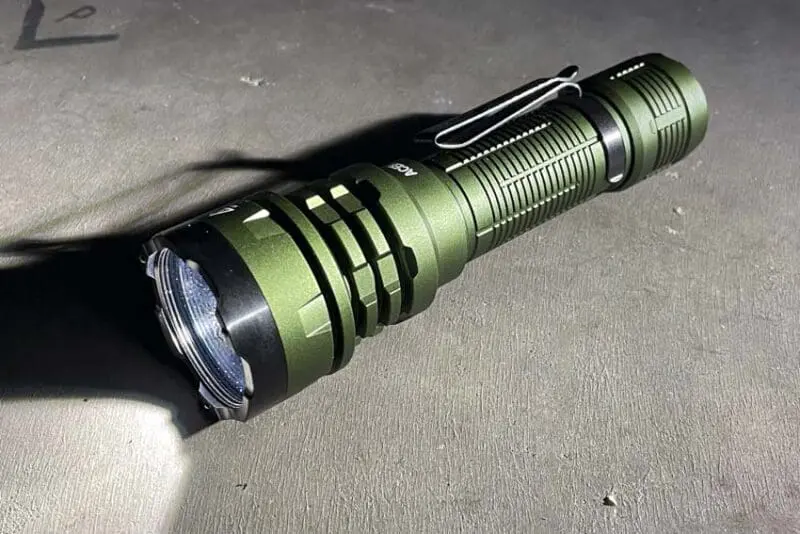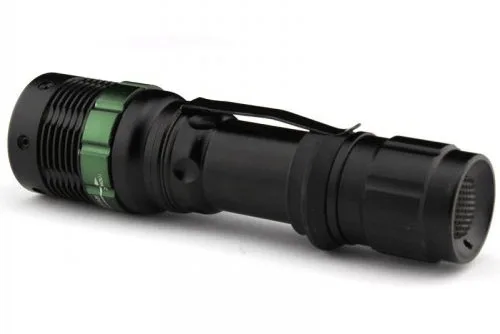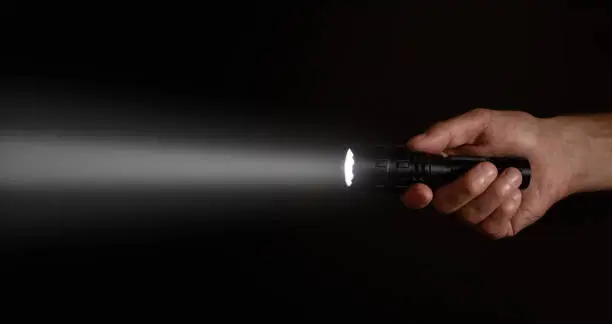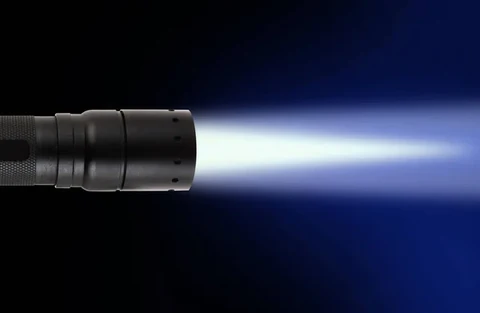Whether you need emergency lighting for power outages, a reliable companion for outdoor adventures, or simply a handy tool to keep in the car, a flashlight can prove indispensable in many scenarios. But with such a wide array of choices—varying in brightness, size, battery type, beam distance, and special features—buying the right flashlight can be surprisingly complex. Do you need a super-bright torch for hiking? A pocketable pen light for everyday carry? A rugged flashlight for professional use? This guide will take you through the fundamental considerations, so you can select a flashlight that perfectly suits your needs.
1. Defining Your Primary Purpose
The first step in picking the right flashlight is to identify how and where you plan to use it:
- Everyday Carry (EDC): A small, portable flashlight that fits in your pocket or purse. You might use it for quick tasks—checking a fuse box, lighting your path briefly, or finding dropped items in dark places. Compactness and convenience are top priorities for EDC flashlights.
- Outdoor Recreation: Campers, hikers, anglers, and hunters often require flashlights with high brightness (lumens), rugged construction, and possibly water resistance. Some prefer headlamps for hands-free usage, but a handheld flashlight with strong throw (beam distance) can be essential for spotting trails or wildlife.
- Professional/Industrial Use: Construction workers, police officers, search-and-rescue teams, and mechanics might need sturdy, impact-resistant flashlights with long battery life and specialized features like strobe modes or high-lumen outputs for scanning wide areas.
- Emergency Preparedness: For blackouts or roadside emergencies, you might want a reliable flashlight that can last a long time on lower modes and perhaps runs on common, easy-to-find batteries. Features like a built-in battery gauge, multiple brightness settings, or a tail-stand capability can be helpful.
- Tactical or Self-Defense: Some users seek high-lumen “tactical” flashlights with strobe modes, crenulated bezels for self-defense, and tail switches for one-handed operation. These are often favored by security personnel or anyone wanting an extra layer of personal protection.
By clarifying your primary use or environment, you can hone in on the flashlight characteristics that matter most.

2. Light Output and Brightness
Lumens are the standard measurement of total light output from a flashlight. Higher lumens mean a brighter beam—but brightness isn’t everything. Different tasks may require different outputs:
- Under 100 Lumens: Suitable for small EDC keychain lights or penlights, offering enough brightness for close-up tasks like finding keys or navigating a dark hallway.
- 100–300 Lumens: Common mid-range for general home and light outdoor use, sufficient for reading road maps, camping chores, or walking a dog at night.
- 300–1000 Lumens: A very versatile range. Many outdoor enthusiasts prefer around 500–800 lumens for decent beam throw and wide coverage while hiking or exploring.
- 1000+ Lumens: High-intensity lights that can illuminate distant objects. Great for search tasks, large outdoor areas, or tactical situations. Battery consumption is higher, and heat can be an issue with extended use.
a) ANSI FL1 Standards
Some reputable flashlight manufacturers adhere to ANSI FL1 standards, measuring lumens, beam distance, runtime, and impact resistance in uniform ways. This allows more accurate comparisons. If a flashlight brand references FL1 data, you can trust the stated specs more confidently.
b) Turbo and Other Modes
Many modern flashlights have multiple brightness settings, such as Low, Medium, High, and Turbo. Turbo can push the lumens to a very high level but often only for short durations before the flashlight steps down to prevent overheating. Ensure you check real-world reviews or details about thermal regulation and how long the light can sustain peak brightness.
3. Beam Type and Distance
Not all bright lights are created equal. The type of beam can impact how the flashlight’s luminous flux is distributed:
- Flood Beam: A broad, diffused beam that lights up a wide area. Ideal for close-up tasks, camping areas, or short-distance illumination.
- Spot / Throw Beam: A narrower, focused beam designed to reach farther distances—useful for signaling, search and rescue, or scanning a distant object.
- Combo / Adjustable Beam: Some flashlights allow you to adjust the focus from flood to spot. This can be versatile if you need both up-close illumination and distance spotting in the same outing.
a) Beam Distance
Measured in meters, beam distance indicates how far the flashlight can shine before the brightness drops to 0.25 lux (approximately the brightness of a full moon). If you need to see objects far away—like across a field—opt for a flashlight with a high beam distance, typically 200m or more.
b) Candela vs. Lumens
While lumens measure total light output, candela measures the beam intensity at the brightest point. A flashlight with a high candela rating can project a tighter, more intense beam, resulting in greater throw. If you require maximum distance, looking at candela measurements is valuable.
4. Power Source and Battery Type
A flashlight’s power source is a critical consideration. Factors like battery availability, cost, runtime, and eco-friendliness come into play:
- Disposable Alkaline Batteries (AA, AAA, C, D): Easy to find in stores, making them convenient during emergencies. However, they can be less cost-effective in the long run and have limited voltage.
- Rechargeable Li-ion Batteries (e.g., 18650, 21700): Higher voltage, capacity, and better performance. They can handle high-drain requirements for high-lumen output. You’ll need either an external charger or a flashlight with built-in USB charging.
- NiMH Rechargeable AA or AAA: Good middle ground if you need the convenience of a standard form factor but want a rechargeable solution.
- Built-in USB Battery: Some flashlights come with integrated batteries that you recharge via USB-C or micro-USB. Great for convenience, but replacing the internal battery might be tricky or impossible if it degrades.
- CR123A Lithium (Disposable) or RCR123 (Rechargeable): Small, high-voltage cells often used in tactical flashlights. They offer good shelf life and performance in cold temperatures but can be more expensive and harder to find.
a) Runtime Considerations
Check the manufacturer’s runtime specs. They might say something like “3 hours at 500 lumens, 30 hours at 30 lumens.” If you need extended usage (like overnight camping), consider a flashlight with a large battery capacity or efficient lower modes. Also note that some flashlights reduce brightness after a certain period to manage heat and power usage, so real-world runtime may differ from the labeled time at “full power.”
b) Backup and Emergencies
For emergency preparedness, you might prefer a flashlight that uses easily accessible AA or AAA batteries, ensuring you can buy replacements almost anywhere. Others prefer rechargeable Li-ion for daily usage to avoid constantly purchasing disposables.

5. Construction, Durability, and Weather Resistance
a) Material and Build
Common flashlight body materials include:
- Aluminum: Durable and lightweight, often used in mid- to high-end flashlights.
- Stainless Steel: Very tough, though heavier.
- Titanium: Premium, strong, and lightweight, but expensive.
- Polymer/Plastic: Usually more budget-friendly, can be lightweight, but might be less durable.
b) Impact Resistance
If you expect rough usage—dropping the flashlight on concrete or hitting it on rocks—look for an impact resistance rating, typically measured in meters (e.g., 1m, 2m). This indicates the flashlight can survive falls from that height onto a hard surface without significant damage.
c) Water Resistance
IPX ratings or IP ratings indicate how water or dust resistant the flashlight is:
- IPX4: Splash resistant; can handle rain or splashes.
- IPX7: Submersible up to 1 meter for 30 minutes.
- IPX8: Submersible beyond 1 meter, typically suitable for diving lights or extended underwater usage.
For general outdoor use, an IPX7 or IPX8 rating is comforting, ensuring you can use the flashlight in heavy rain or even drop it in a stream without worry.
6. User Interface and Controls
A flashlight’s switch or user interface can make or break the user experience:
- Tail Switch: Positioned on the end of the flashlight, commonly found in tactical models. Allows momentary on/off with a half-press. Some prefer tail switches for one-handed operation.
- Side Switch: A button on the flashlight body, often convenient for cycling brightness levels or toggling modes.
- Combination: Some advanced models have both a tail switch for quick activation and a side switch for mode adjustments.
a) Modes and Programming
Many modern flashlights have multiple brightness levels and special modes (strobe, SOS, beacon, etc.). Check if the user interface is intuitive—do you long-press to change modes, double-click for strobe, or do complicated sequences? A complicated UI might frustrate you, especially in urgent situations.
b) Mode Memory
Some flashlights remember the last used mode, turning on in that same mode next time. Others always start on Low or High by default. If you want a consistent start-up mode, verify how the memory function works.

7. Size, Weight, and Ergonomics
a) Pocketability
If you want to carry the flashlight daily, compact and lightweight models—often referred to as EDC flashlights—fit easily in pockets or small pouches. Look for a pocket clip that’s sturdy and well-placed for easy retrieval. Some people also like a flashlight with a tail stand capability (flat tailcap) so it can stand upright on a table, acting like a mini lamp.
b) Grip and Texture
An aggressive knurling or textured body can improve grip, helpful in wet conditions or if you’re wearing gloves. However, overly rough edges can be uncomfortable in a pocket. Meanwhile, smooth surfaces might slip out of your hand if you’re sweaty or in the rain.
c) Weight Distribution
Heavier flashlights might be front-heavy if they house a large reflector for a deep throw beam. Others might balance the weight more centrally. Trying different models or reading reviews can help determine if the flashlight feels comfortable in extended use.
8. Special Features and Accessories
a) Rechargeable vs. Swappable Batteries
Some flashlights feature built-in USB charging (micro-USB or USB-C) that eliminates the need for a separate charger. This is convenient if you want to charge on-the-go from a power bank or car charger. However, built-in batteries might be harder to replace if they degrade over time. Alternatively, flashlights that rely on removable 18650 or 21700 Li-ion cells let you swap out spares for quick battery changes.
b) Magnetic Tail or Clip
A magnetic tailcap can let you attach the flashlight to a metal surface, acting as a hands-free work light. This is popular with mechanics or anyone doing repairs in low-light areas. Some flashlights have magnetic charging ports, creating a neat, water-resistant charging solution.
c) Strobe, SOS, or Beacon Modes
Tactical or rescue-oriented flashlights might include strobe for self-defense, signaling, or disorienting threats. SOS mode pulses Morse code for emergencies, and a beacon mode might flash intermittently to conserve battery yet remain noticeable.
d) Lockout Function
If you carry the flashlight in a bag or pocket, it’s helpful to have a lockout mode to prevent accidental activation. Some achieve this by twisting the tailcap slightly to break the circuit, while others use a software-based electronic lockout via button presses.
9. Budget Considerations
Flashlights can range from $5 disposable units to $300 high-end premium models. Higher prices can mean better materials, advanced LED tech, stronger warranty, and reliable brand reputation. However, many mid-range flashlights (around $30–$100) offer an excellent balance of performance and value. Evaluate what features matter most—like water resistance, high lumens, or brand reliability—and see if a mid-level or high-end brand is worth the investment for your use.
10. Brand Reputation and Warranty
Well-known flashlight manufacturers (e.g., Fenix, Olight, SureFire, Streamlight, Nitecore, ThruNite) have established reputations for quality, reliability, and customer service. They often adhere to ANSI standards and offer robust warranties. Budget off-brand options may provide decent specs on paper, but they can fail in build quality, battery safety, or overstated brightness claims. If you rely heavily on your flashlight—say, in a professional setting—investing in a trusted brand can bring peace of mind.
11. Tailoring Choices for Specific Use Cases
- Everyday Carry: Look for small pocket flashlights with ~100–300 lumens, a single AA or AAA battery, or a small Li-ion cell, and easy operation (one or two modes).
- Camping and Hiking: A broad range (100–800 lumens) with multiple modes, decent water resistance (IPX6 or higher), good battery life, and a balanced flood/throw beam. Possibly a headlamp as well for hands-free tasks.
- Professional/Tactical: Durable aluminum or steel body, high lumens (500+), tail switch, strobe function, good grip, and a brand known for reliability.
- Home Emergency: A mid-lumen (200–400 lumens) flashlight powered by easy-to-find AA or AAA batteries or a large D-cell for extended runtime. Ensures you can quickly replace batteries in blackouts.
- Serious Outdoor Search: High-lumen output with large reflectors or specialized TIR optics for maximum throw, possibly multiple 18650/21700 batteries or larger packs, and robust construction for rugged conditions.

12. Trying It Out and Reading Reviews
While you can read specs and manufacturer claims, it’s also wise to check:
- User Reviews: They often reveal real-world battery life, how hot the flashlight gets at high output, and durability aspects.
- Beam Shots: Some reviewers provide beam comparison photos in various environments (indoor, outdoor) so you can gauge beam pattern.
- Hands-On: If you can, test out a friend’s flashlight or visit a store to see how it feels in your hand, check weight, switch placement, and brightness.
13. Maintenance and Care
A good flashlight should last years if you handle it properly:
- Clean Contacts: Dirty battery contacts can reduce performance or cause flickering. Wipe them occasionally with alcohol.
- Lubricate Threads: If the flashlight has O-rings or twist mechanisms, a small dab of silicone grease keeps them waterproof and prevents wear.
- Avoid Over-discharge: If using Li-ion batteries, don’t let them fully deplete for extended periods. Store them partially charged if not in use.
- Check for Battery Leaks: With alkaline cells, remove them if storing the flashlight for a long period, preventing corrosive leaks.
14. Pitfalls to Avoid
a) Overly High Lumen Obsession
Yes, a 2000-lumen flashlight can be fun. But super-high lumens usually means higher cost, faster battery drain, and more heat. If you rarely need extreme brightness, a moderate-lumen flashlight with efficient modes might be more practical.
b) Skimping on Build Quality
Cheaper lights might have subpar switches, poor threading, or easily cracked lenses. If your flashlight fails at a critical moment—like a roadside emergency—having saved $10 or $20 may not feel worthwhile. Look for a balance between budget and reliability.
c) Ignoring Battery Replacements or Charging
Don’t buy a unique proprietary battery system that’s hard to replace or find spares for. If the flashlight needs specialized cells only sold by the manufacturer, it can be inconvenient or expensive long-term.

15. Conclusion
A flashlight is more than just a device that shines light—it’s a potential lifesaver during power outages, a beacon on outdoor expeditions, and a daily tool for myriad tasks. With so many variations in size, brightness, power source, and design, selecting the right one demands understanding your specific needs, usage patterns, and budget.
- Determine Use Case: Everyday carry, professional work, outdoor exploration, or emergency backup.
- Evaluate Core Specs: Lumens, beam distance, battery type, runtime, water/impact resistance.
- Assess Practical Features: Switch design, user interface, available modes, beam pattern, size, and weight.
- Balance Cost and Quality: A mid-range to premium flashlight from a reputable brand is typically a solid investment in reliability.
- Maintain and Protect: Clean contacts, store batteries properly, and keep O-rings lubed for longevity.
Ultimately, the “best flashlight” is the one that meets your lighting demands consistently, feels comfortable in hand, and won’t let you down when you need it most. By keeping these considerations in mind, you’ll be able to choose a flashlight that provides reliable illumination for all your adventures—be they household chores, outdoor escapades, or professional missions. When the lights go out or you’re traversing dark trails, you’ll be glad you chose wisely.
